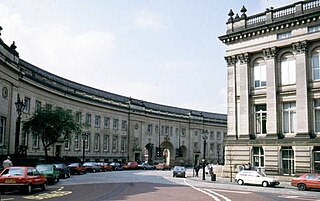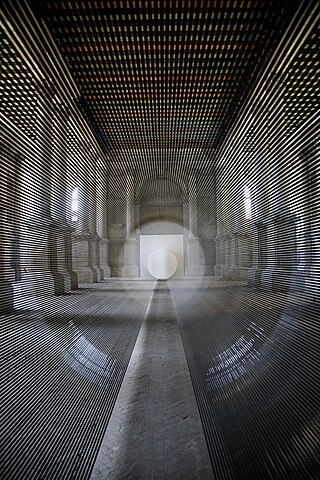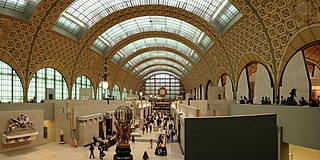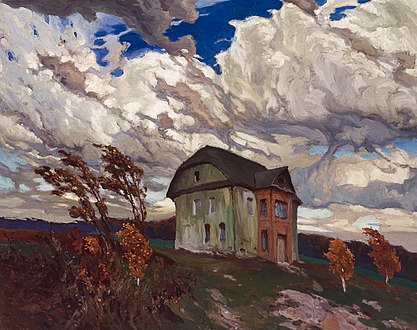
The British Museum is a public museum dedicated to human history, art and culture located in the Bloomsbury area of London. Its permanent collection of eight million works is among the largest and most comprehensive in existence. It documents the story of human culture from its beginnings to the present. The British Museum was the first public national museum to cover all fields of knowledge.

An art museum or art gallery is a building or space for the display of art, usually from the museum's own collection. It might be in public or private ownership and may be accessible to all or have restrictions in place. Although primarily concerned with visual art, art museums are often used as a venue for other cultural exchanges and artistic activities, such as lectures, performance arts, music concerts, or poetry readings. Art museums also frequently host themed temporary exhibitions, which often include items on loan from other collections.

The National Museum of Art in Norway, also known simply as the National Museum, shortened NaM is a Norwegian state-owned museum in Oslo. It holds the Norwegian state's public collection of art, architecture, and design objects. The collection totals over 400.000 works, amongst them the first copy of Edvard Munch's The Scream from 1893.

The National Museum in New Delhi, also known as the National Museum of India, is one of the largest museums in India. Established in 1949, it holds a variety of articles ranging from pre-historic era to modern works of art. It functions under the Ministry of Culture, Government of India. The museum is situated on Janpath. The blue–print of the National Museum had been prepared by the Gwyer Committee set up by the Government of India in 1946. The museum has around 200,000 works of art, mostly Indian, but some of foreign origin, covering over 5,000 years.

The National Museum in Warsaw, popularly abbreviated as MNW, is a national museum in Warsaw, one of the largest museums in Poland and the largest in the capital. It comprises a rich collection of ancient art, counting about 11,000 pieces, an extensive gallery of Polish painting since the 16th century and a collection of foreign painting including some paintings from Adolf Hitler's private collection, ceded to the museum by the American authorities in post-war Germany. The museum is also home to numismatic collections, a gallery of applied arts and a department of oriental art, with the largest collection of Chinese art in Poland, comprising some 5,000 objects.

Lithuania attracts many visitors from neighbouring countries and all over the world. In 2018, 1,7 million foreign visitors arrived to Lithuania for business, family and leisure. Historical legacy of the Grand Duchy of Lithuania, rich history, architecture, pristine nature, seaside and SPA resorts are the main attraction points of Lithuania. Domestic tourism is also highly popular – in 2018 it grew by 12% percent. Lithuanians also prefer to spend their vacations in Lithuania – 70 percent.

Bolton Museum is a public museum and art gallery in the town of Bolton, England, owned by Bolton Metropolitan Borough Council. The museum is housed within the grade II listed Le Mans Crescent near Bolton Town Hall and shares its main entrance with the central library in a purpose-built civic centre. The building has good accessibility.

The Museum of Byzantine Culture is a museum in Thessaloniki, Central Macedonia, Greece, which opened in 1994.
Kazys Varnelis was an abstract painter from Lithuania. He lived and worked in the United States of America for fifty years, between 1949 and 1998. His distinctive painting style demonstrated optical and three-dimensional illusions based on geometric abstractions and minimal forms. His style combined elements of constructivism, minimalism, and op art. His work is sometimes described as a modernist interpretation of Lithuanian folk art and is owned by Solomon R. Guggenheim Museum, the Art Institute of Chicago, Currier Museum of Art, and other museums. Varnelis was also an avid collector of antiques and bibliophile – his collection is now housed at the Kazys Varnelis House–Museum in Vilnius. His son, also named Kazys Varnelis is a noted architect, art historian, and theorist.
Virginija Jasiūnaitė-Juršienė is a Lithuanian ceramic artist.
Vidmantas Jusionis is a Lithuanian painter.

Žilvinas Kempinas is a contemporary visual artist. He lives and works in New York City.
Juozas Lebednykas is a Lithuanian artist and sculptor.

Modern Gallery is a museum in Zagreb, Croatia that holds the most important and comprehensive collection of paintings, sculptures and drawings by 19th and 20th century Croatian artists. The collection numbers around 10,000 works of art, housed since 1934 in the historic Vranyczany Palace in the centre of Zagreb, overlooking the Zrinjevac Park. A secondary gallery is the Josip Račić Studio at Margaretska 3.

Vytenis Jankūnas is a Lithuanian-American artist living and working in New York City. His work consists of photographs, paintings and mixed media works.
Deimantas Narkevičius is one of the most consistent and widely recognised Lithuanian artists on the international art scene. Originally trained as a sculptor, Narkevičius has mainly worked with film and video. Employing documentary footage, voice-overs, interviews, re-enactments and found photographs, his films submit historical events to the narrative structures of storytelling and cinema. In his artistic practice Narkevičius examines the relationship of personal memories to political histories, particularly those of his native Lithuania. For the artist, history itself has become both material and methodology.

MO Museum is a modern art museum in Vilnius, Lithuania. As a private initiative of Lithuanian scientists and philanthropists Danguolė Butkienė and Viktoras Butkus, it functioned as an art museum without walls for about ten years. The collection of 5,000 modern and contemporary pieces contains major Lithuanian artworks from the 1950s to the present day.

The 136 museums in the city of Paris display many historical, scientific, and archeological artifacts from around the world, covering diverse and unique topics including fashion, theater, sports, cosmetics, and the culinary arts.

The Lithuanian Art Society was a society that organized Lithuanian art exhibitions and supported Lithuanian artists. Based in Vilnius, it was active from 1907 to the outbreak of World War I in 1914. It was chaired by painter Antanas Žmuidzinavičius. The society was established after the first Lithuanian art exhibition was successfully organized in early 1907. The society continued to organize annual exhibitions that displayed works both by professional and folk artists. Influenced by the Arts and Crafts movement, the society paid great attention to Lithuanian folk art which was increasingly seen as an expression of the Lithuanian character. In 1912, the society published an album of drawings of Lithuanian crosses, column shrines, and roofed poles, which is considered the first study of Lithuanian folk art. The society was also instrumental in preserving the art of Mikalojus Konstantinas Čiurlionis and organized his first solo exhibitions in 1911 and 1913. The society also collected works by other artists and worked with the Lithuanian Scientific Society to establish a Lithuanian art museum. The collection was transferred to the present-day M. K. Čiurlionis National Art Museum in 1920.



















